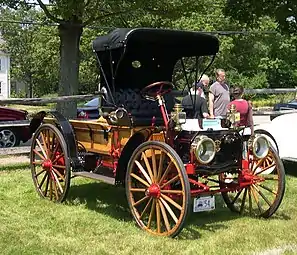The International Harvester Auto-Buggy is a two-cylinder, air-cooled motor car made by International Harvester Corporation. First announced in February 1907, the Auto-Buggy was dropped from their range of products in early 1912, but the Auto Wagon continued to 1917.[1]
Auto Buggy

Supplied with a pair of bench seats to carry four passengers, it was powered by an engine set beneath the car's body, a two-cylinder, horizontally opposed, air cooled design that produced 18-20 horsepower. It had two forward gears and one reverse gear with a chain-drive system to the large "high-wheel", wagon-style, rubber-shod wheels at the back.[2] Its high wheels and wide stance gave it the stability and ground clearance to cope with poor roads. Accessories such as a canvas top were optional.[1]
Buyers found it tough and reliable. The many widespread International Harvester dealers made service easy to find.[1]
The Buggy was considered a car, so in 1912, when IHC decided to market just trucks, it was dropped.[1]
Auto Wagon
Late in 1908, a variant was announced with a single bench seat mounted on a well-sided tray in place of the Buggy's automobile-styled body. A second bench seat could be mounted on the Wagon's tray, still leaving a very short tray available behind it. IHC's first true truck, it was tagged their Model A from 1908 to 1911. A wide-track version was tagged Model B. Auto Wagon sales in 1909 led the emerging light-truck market.[1]
In fact, the Wagon had the same chassis and the Wagon seat and tray combination could be put straight onto a Buggy chassis.[1]
_(cropped).jpg.webp) Auto Wagon
Auto Wagon Auto Wagon with tray one bench seat and hood
Auto Wagon with tray one bench seat and hood.jpg.webp) A 1912 Auto Wagon two bench seats and tray
A 1912 Auto Wagon two bench seats and tray.jpg.webp) Auto Wagon two bench seats and short tray
Auto Wagon two bench seats and short tray_(cropped).jpg.webp) Auto Wagon with three bench seats
Auto Wagon with three bench seats
- 1907 to 1911 Model AA (air-cooled)
- 1907 to 1911 Model AW (water-cooled)
- 1912 to 1917 Model MA (air-cooled) load 800 lbs
- or Model MW (water-cooled)
- or Model MAX (air-cooled and wide-track)[1]
The range of bodies available included pickup, delivery, stake-type, panel delivery, and bus. Some became fire trucks.
- Pneumatic tires became an option.
- 1915 to 1917 Model M ½-ton load 1000 lbs
- 1915 to 1917 Model E ¾-ton load 1500 lbs[1]
.jpg.webp) 1912 Auto Wagon cranking
1912 Auto Wagon cranking.jpg.webp) Chain drive
Chain drive.jpg.webp) 1914 MW
1914 MW
Replaced by Model F
Announced in 1915, full production of the Auto Wagon replacement began in 1917. Quite different in appearance, it had a sloping "coffin-nose", and more importantly, it was a water-cooled four-cylinder without chain drive, and it had low wheels and either solid or pneumatic tires.
See also
References